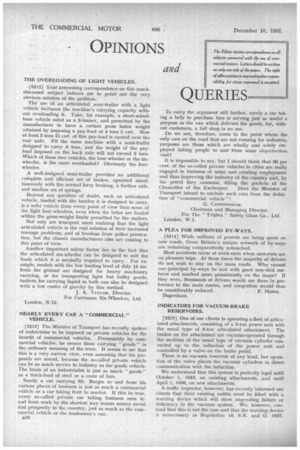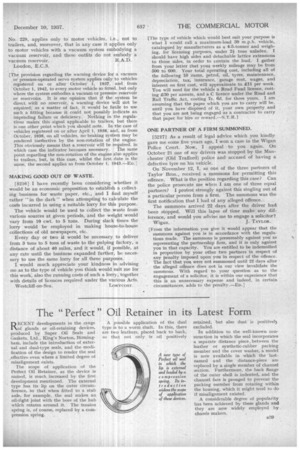OPINIONS
Page 20

Page 21

If you've noticed an error in this article please click here to report it so we can fix it.
and
QUERIES
THE OVERLOADING OF LIGHT VEHICLES.
[5212] Your interesting correspondence on this muchdiscussed subject induces me to point out the very obvious solutiOn of the problem. • The use of an articulated semi-trailer with a light vehicle increases the machine's carrying capacity without overloading it. Take, for example, a short-wheelbase vehicle rated as a 3-tonner, and permitted by the manufacturer to have a certain gross laden weight attained by imposing a pay-load of 4 tons 5 cwt. Now at least 3 tons 15 cwt. of this pay-load is carried over the rear axle. Fit the same machine with a semi-trailer designed to carry 6 tons, and the weight of the payload imposed on the back axle will not exceed 3 tons. Which of these two vehicles, the four-wheeler or the sixWheeler, is the more overloaded? Obviously the fourwheeler.
A well-designed semi-trailer provides an additional complete and efficient set of brakes, operated simul. taneously with the normal lorry braking, a further axle, and another set of springs.
Beyond any question of doubt, such an articulated vehicle, loaded with the burden it is designed to carry, is a safer vehicle from every point of view than some of the light four-wheelers, even when the latter are loaded within the gross-weight limits permitted by the makers.
Not only are transport users realizing that the light articulated vehicle is the real solution of their increased tonnage problems, and of freedom from police persecution, but the chassis manufacturers also are coming to this point of view.
Another important safety factor. lies in the fact that the articulated six-wheeler can be designed to suit the loads which it is normally required to carry. For example, models with the low loading level of Only 18 ins. from the ground are designed for heavy machinery carrying, or for transporting light but bulky goods; tankers for carrying liquid in bulk can also be designed with a low centre of gravity by this method.
J. A. TAYLOR, Director.
For Carrimore Six-Wheelers, Ltd. London, N.12.
NEARLY EVERY CAR A "COMMERCIAL" VEHICLE.
[5213] The Minister of Transport has recently spoken of restrictions to be imposed on private vehicles for the benefit of eommercial vehicles. Presumably by commercial vehicles, he means those carrying " goods " in the ordinary meaning of the term. It seems to me that this is a very narrow view, even assuming that his proposals are sound, because the so-called private vehicle can be as much service to industry as the goods vehicle. The brain of an industrialist is just as much " goods " as a truck-load of steel or a crate of furs.
Surely a car carrying Mr. Burgin to and from' his various places of business is just as much a commercial vehicle as a car taking fruit to market. If this be true, every so-called private car taking business men to and from work by the shortest way means money saved drid. prosperity to the country, just as much as the commercial vehicle or the tradesman's van.
n38 To carry the argument still farther, surely a car taking a lady to purchase furs is serving just as useful a purpose as the van which delivers the goods, for, without customers, a full shop is no use.
Do we not, therefore, come to the point where the only cars on the road that are not running for industrial purposes are those which are wholly and solely employed taking people to and from some objectiveless visit?
It is impossible to say, but I should think that 99 per cent, of the so-called private vehicles in cities are really engaged in business of some sort creating employment and thus improving the industry of the country and, by the petrol they consume, filling the pockets of the Chancellor of the Exchequer. Does the Minister ofTransport intend to exclude such cars from the definition of "commercial vehicle "?
G. CUNNINGHAM, Chairman and Managing Director.
For The " Triplex " Safety Glass Co., Ltd. London, W.1.
A PLEA FOR IMPROVED BY-WAYS.
[5214] While millions of pounds are being spent on new roads, Great Britain's unique network of by-ways are remaining comparatively untouched.
Most accidents occur at week-ends when motorists are on pleasure trips. At these times the majority of drivers do not wish to stay on the main roads. Why cannot our principal by-ways be laid with good non-skid surfaces and marked more prominently on the maps? If they were, thousands of drivers would use them in preference to the main routes, and congestion would thus be considerably reduced. F. HOWE. Dagenham.
INDICATORS FOR VACUUM-BRAKE RESERVOIRS.
[5215] One of our clients is operating a fleet of articulated attachments, consisting of a 3-ton power unit with the usual type of 6-ton articulated attachment. The brakes on the attachment are vacuum-operated through the medium of the usual type of vacuum cylinder connected up to the induction of the power unit and controlled by a valve on the brake pedal.
There is no vacuum reservoir of any kind, but operation of the valve places the vacuum cylinders in direct communication with the induction.
We understand that this system is perfectly legal until October 1, 1943, on existing attachments, and until April 1, 1938, on new attachments.
A traffic inspector, however, has recently informed our clients that their existing outfits must be fitted with a warning device which will show impending failure or deficiency in the vacuum system. We, however, contend that this is not the case and that the warning device is unnecessary as Regulation 10, S.R. and 0. 1937,
No. 229, applies only to motor vehicles, i.e., not to trailers, and, moreover, that in any case it applies only to motor vehicles with a vacuum system embodying a vacuum reservoir, and these outfits do not embody a vacuum reservoir. R.A.D. London, E.C.3.
[The provision regarding the warning device for a vacuum or pressure-operated servo system applies only to vehicles registered on or after October 1, 1937, and from October 1, 1942, to every motor vehicle so fitted, but only where the system embodies a vacuum or pressure reservoir or reservoirs. It is our opinion that if the system be direct, with no reservoir, a warning device will not be required; as a matter of fact, it would be futile to use such a fitting because it could not possibly indicate an impending failure or deficiency: Nothing in the regulations makes this signal applicable to trailers, but there is one other point which you should note. In the case of vehicles registered on or after April 1, 1938, and, as from October, 1938, on all vehicles, no-braking system may be rendered ineffective by the non-rotation of the engine. This obviously means that a reservoir will be required, in which case the indicator becomes necessary. The same point regarding the non-rotation of the engine also applies to trailers, but, in this case, whilst the first date is the same, the second applies as from October 1, 1943.—ED.] MAKING GOOD OUT OF WASTE.
[5216] I have recently been considering whether it would be an economic proposition to establish a collecting business for waste paper, etc., and I find myself rather "in the dark" when attempting to calculate the costs incurred in using a suitable lorry for this purpose.
The vehicle would be used to collect the waste from various sources at .given periods, and the weight would vary from 10 cwt. to 5 tons. During slack times the lorry would be employed in making house-to-house collections of old newspapers, etc.
Every day or two it would be necessary to deliver from 3 tons to 5 tons of waste to the pulping factory, a distance of about 40 miles, and it would, if possible, at any rate until the business expanded further, be necessary to use the same lorry for all three purposes.
I would much appreciate your kindness in advising me as to the type of vehicle you think would suit me for this work, also the running costs of such a lorry, together with details of licences required under the various Acts.
Westcliff-on-Sea, LORYcOST. [The type of vehicle which would best suit your purpose is what I would call a maximum-load 30 m.p.h. vehicle, catalogued by manufacturers as a 4-5-tonner and weighing, for licensing purposes, under 2i tons unladen. I should have high sides and detachable lattice extensions to those sides, in order to contain the load. I gather from your letter that your weekly mileage may be from 500 to 600. Your total operating cost, including all of the following 10 items, petrol, oil, tyres, maintenance. depreciation, tax, insurance, garage rent, wages, and interest on first cost, will approximate to 11 per week. You will need for the vehicle a Road Fund licence, coSting 30 per annum, and a C licence under the Road and Rail Traffic Act, costing 7s. fki. for three years. I am assuming that the paper which you are to carry will be, until you have disposed of it, your own property and that you are not being engaged as a contractor to carry that paper, for hire or reward.—S.T.R.] ONE PARTNER OF A FIRM SUMMONED.
[5217] As a result of legal advice which you kindly gave me some five years ago, I won a case in the Wigan Police Court. Now, I appeal to you again. On October 21 one of my drivers was stopped by the Manchester (Old Trafford) police and accused of having a defective tyre on his vehicle.
On November 12, 1, as one of the three partners of Taylor Bros., received a snmmons for permitting this offence. What is the position regarding this case? Can the police prosecute me when I am one of three equal partners? I protest strongly against this singling out of a particular person from a firm. The summons was the first notification that I had of any alleged offence.
The summons arrived 22 days after the driver had been stopped. Will this lapse of time make any difference, and would you advise me to engage a solicitor?
Wigan. ' j. TAYLOR.
[From the information you give it would appear that the summons against you is in accordance with the regulations made. The summons is presumably against you as representing the partnership firm, and it is only against you in that capacity. You are entitled to be indemnified in proportion by your other two partners in respect of any penalty imposed upon you in respect of the offence. The fact that you were not summoned until 22 days after the alleged offence does not in our view invalidate the summons. With regard to your question as to the engagement of a solicitor, it is within our experience that this is an unnecessary expense and indeed, in certain circumstances, adds to the penalty—ED.]




























